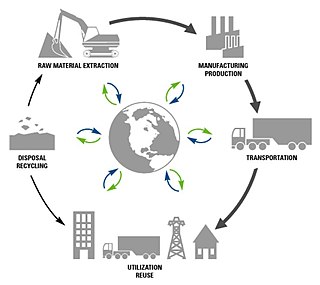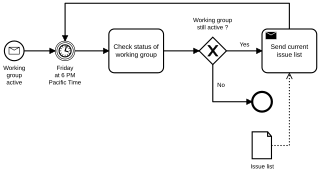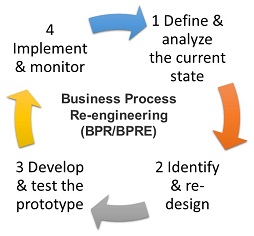An information system (IS) is a formal, sociotechnical, organizational system designed to collect, process, store, and distribute information. From a sociotechnical perspective, information systems comprise four components: task, people, structure, and technology. Information systems can be defined as an integration of components for collection, storage and processing of data, comprising digital products that process data to facilitate decision making and the data being used to provide information and contribute to knowledge.
A business process, business method, or business function is a collection of related, structured activities or tasks performed by people or equipment in which a specific sequence produces a service or product for a particular customer or customers. Business processes occur at all organizational levels and may or may not be visible to the customers. A business process may often be visualized (modeled) as a flowchart of a sequence of activities with interleaving decision points or as a process matrix of a sequence of activities with relevance rules based on data in the process. The benefits of using business processes include improved customer satisfaction and improved agility for reacting to rapid market change. Process-oriented organizations break down the barriers of structural departments and try to avoid functional silos.

In industry, product lifecycle management (PLM) is the process of managing the entire lifecycle of a product from its inception through the engineering, design and manufacture, as well as the service and disposal of manufactured products. PLM integrates people, data, processes, and business systems and provides a product information backbone for companies and their extended enterprises.
In software testing, test automation is the use of software separate from the software being tested to control the execution of tests and the comparison of actual outcomes with predicted outcomes. Test automation can automate some repetitive but necessary tasks in a formalized testing process already in place, or perform additional testing that would be difficult to do manually. Test automation is critical for continuous delivery and continuous testing.

Business process modeling (BPM), mainly used in business process management; software development, or systems engineering, is the action of capturing and representing processes of an enterprise, so that the current business processes may be analyzed, applied securely and consistently, improved, and automated. BPM is typically orchestrated by business analysts, leveraging their expertise in modeling practices. Subject matter experts, equipped with specialized knowledge of the processes being modeled, often collaborate within these teams. Alternatively, process models can be directly derived from digital traces within IT systems, such as event logs, utilizing process mining tools.
A data-flow diagram is a way of representing a flow of data through a process or a system. The DFD also provides information about the outputs and inputs of each entity and the process itself. A data-flow diagram has no control flow — there are no decision rules and no loops. Specific operations based on the data can be represented by a flowchart.

Business process re-engineering (BPR) is a business management strategy originally pioneered in the early 1990s, focusing on the analysis and design of workflows and business processes within an organization. BPR aims to help organizations fundamentally rethink how they do their work in order to improve customer service, cut operational costs, and become world-class competitors.
Enterprise content management (ECM) extends the concept of content management by adding a timeline for each content item and, possibly, enforcing processes for its creation, approval, and distribution. Systems using ECM generally provide a secure repository for managed items, analog or digital. They also include one methods for importing content to manage new items, and several presentation methods to make items available for use. Although ECM content may be protected by digital rights management (DRM), it is not required. ECM is distinguished from general content management by its cognizance of the processes and procedures of the enterprise for which it is created.
A functional software architecture (FSA) is an architectural model that identifies enterprise functions, interactions and corresponding IT needs. These functions can be used as a reference by different domain experts to develop IT-systems as part of a co-operative information-driven enterprise. In this way, both software engineers and enterprise architects can create an information-driven, integrated organizational environment.

Enterprise integration is a technical field of enterprise architecture, which is focused on the study of topics such as system interconnection, electronic data interchange, product data exchange and distributed computing environments.
Business analysis is a professional discipline focused on identifying business needs and determining solutions to business problems. Solutions may include a software-systems development component, process improvements, or organizational changes, and may involve extensive analysis, strategic planning and policy development. A person dedicated to carrying out these tasks within an organization is called a business analyst or BA.

Business Process Model and Notation (BPMN) is a graphical representation for specifying business processes in a business process model.

Enterprise modelling is the abstract representation, description and definition of the structure, processes, information and resources of an identifiable business, government body, or other large organization.
Business process discovery (BPD) related to business process management and process mining is a set of techniques that manually or automatically construct a representation of an organisations' current business processes and their major process variations. These techniques use data recorded in the existing organisational methods of work, documentations, and technology systems that run business processes within an organisation. The type of data required for process discovery is called an event log. Any record of data that contains the case id, activity name, and timestamp. Such a record qualifies for an event log and can be used to discover the underlying process model. The event log can contain additional information related to the process, such as the resources executing the activity, the type or nature of the events, or any other relevant details. Process discovery aims to obtain a process model that describes the event log as closely as possible. The process model acts as a graphical representation of the process. The event logs used for discovery could contain noise, irregular information, and inconsistent/incorrect timestamps. Process discovery is challenging due to such noisy event logs and because the event log contains only a part of the actual process hidden behind the system. The discovery algorithms should solely depend on a small percentage of data provided by the event logs to develop the closest possible model to the actual behaviour.
Kepler is a free software system for designing, executing, reusing, evolving, archiving, and sharing scientific workflows. Kepler's facilities provide process and data monitoring, provenance information, and high-speed data movement. Workflows in general, and scientific workflows in particular, are directed graphs where the nodes represent discrete computational components, and the edges represent paths along which data and results can flow between components. In Kepler, the nodes are called 'Actors' and the edges are called 'channels'. Kepler includes a graphical user interface for composing workflows in a desktop environment, a runtime engine for executing workflows within the GUI and independently from a command-line, and a distributed computing option that allows workflow tasks to be distributed among compute nodes in a computer cluster or computing grid. The Kepler system principally targets the use of a workflow metaphor for organizing computational tasks that are directed towards particular scientific analysis and modeling goals. Thus, Kepler scientific workflows generally model the flow of data from one step to another in a series of computations that achieve some scientific goal.

In systems engineering, software engineering, and computer science, a function model or functional model is a structured representation of the functions within the modeled system or subject area.
Business process management (BPM) is the discipline in which people use various methods to discover, model, analyze, measure, improve, optimize, and automate business processes. Any combination of methods used to manage a company's business processes is BPM. Processes can be structured and repeatable or unstructured and variable. Though not required, enabling technologies are often used with BPM.
KNIME, the Konstanz Information Miner, is a free and open-source data analytics, reporting and integration platform. KNIME integrates various components for machine learning and data mining through its modular data pipelining "Building Blocks of Analytics" concept. A graphical user interface and use of JDBC allows assembly of nodes blending different data sources, including preprocessing, for modeling, data analysis and visualization without, or with minimal, programming.
In philosophy, a process ontology refers to a universal model of the structure of the world as an ordered wholeness. Such ontologies are fundamental ontologies, in contrast to the so-called applied ontologies. Fundamental ontologies do not claim to be accessible to any empirical proof in itself but to be a structural design pattern, out of which empirical phenomena can be explained and put together consistently. Throughout Western history, the dominating fundamental ontology is the so-called substance theory. However, fundamental process ontologies have become more important in recent times, because the progress in the discovery of the foundations of physics has spurred the development of a basic concept able to integrate such boundary notions as "energy," "object", and those of the physical dimensions of space and time.
Artifact-centric business process model represents an operational model of business processes in which the changes and evolution of business data, or business entities, are considered as the main driver of the processes. The artifact-centric approach, a kind of data-centric business process modeling, focuses on describing how business data is changed/updated, by a particular action or task, throughout the process.








